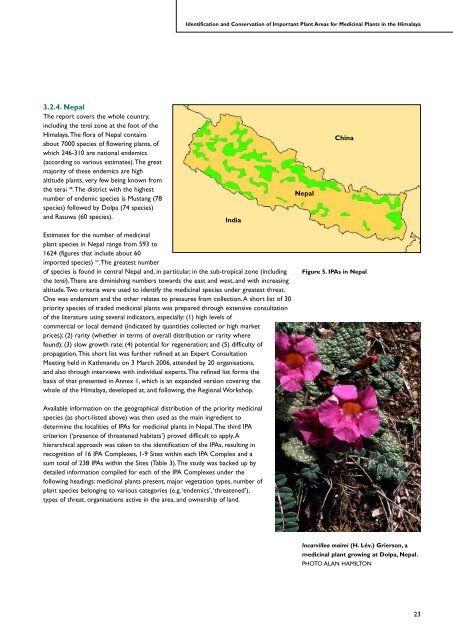Identification and Conservation of Important Plant Areas - Plantlife
Identification and Conservation of Important Plant Areas - Plantlife
Identification and Conservation of Important Plant Areas - Plantlife
- No tags were found...
You also want an ePaper? Increase the reach of your titles
YUMPU automatically turns print PDFs into web optimized ePapers that Google loves.
<strong>Identification</strong> <strong>and</strong> <strong>Conservation</strong> <strong>of</strong> <strong>Important</strong> <strong>Plant</strong> <strong>Areas</strong> for Medicinal <strong>Plant</strong>s in the Himalaya3.2.4. NepalThe report covers the whole country,including the terai zone at the foot <strong>of</strong> theHimalaya.The flora <strong>of</strong> Nepal containsabout 7000 species <strong>of</strong> flowering plants, <strong>of</strong>which 246-310 are national endemics(according to various estimates).The greatmajority <strong>of</strong> these endemics are highaltitude plants, very few being known fromthe terai 48 .The district with the highestnumber <strong>of</strong> endemic species is Mustang (78species) followed by Dolpa (74 species)<strong>and</strong> Rasuwa (60 species).IndiaNepalChinaEstimates for the number <strong>of</strong> medicinalplant species in Nepal range from 593 to1624 (figures that include about 60imported species) 57 .The greatest number<strong>of</strong> species is found in central Nepal <strong>and</strong>, in particular, in the sub-tropical zone (includingthe terai).There are diminishing numbers towards the east <strong>and</strong> west, <strong>and</strong> with increasingaltitude.Two criteria were used to identify the medicinal species under greatest threat.One was endemism <strong>and</strong> the other relates to pressures from collection.A short list <strong>of</strong> 30priority species <strong>of</strong> traded medicinal plants was prepared through extensive consultation<strong>of</strong> the literature using several indicators, especially: (1) high levels <strong>of</strong>commercial or local dem<strong>and</strong> (indicated by quantities collected or high marketprices); (2) rarity (whether in terms <strong>of</strong> overall distribution or rarity wherefound); (3) slow growth rate; (4) potential for regeneration; <strong>and</strong> (5) difficulty <strong>of</strong>propagation.This short list was further refined at an Expert ConsultationMeeting held in Kathm<strong>and</strong>u on 3 March 2006, attended by 20 organisations,<strong>and</strong> also through interviews with individual experts.The refined list forms thebasis <strong>of</strong> that presented in Annex 1, which is an exp<strong>and</strong>ed version covering thewhole <strong>of</strong> the Himalaya, developed at, <strong>and</strong> following, the Regional Workshop.Figure 5. IPAs in NepalAvailable information on the geographical distribution <strong>of</strong> the priority medicinalspecies (as short-listed above) was then used as the main ingredient todetermine the localities <strong>of</strong> IPAs for medicinal plants in Nepal.The third IPAcriterion (‘presence <strong>of</strong> threatened habitats’) proved difficult to apply.Ahierarchical approach was taken to the identification <strong>of</strong> the IPAs, resulting inrecognition <strong>of</strong> 16 IPA Complexes, 1-9 Sites within each IPA Complex <strong>and</strong> asum total <strong>of</strong> 238 IPAs within the Sites (Table 3).The study was backed up bydetailed information compiled for each <strong>of</strong> the IPA Complexes under thefollowing headings: medicinal plants present, major vegetation types, number <strong>of</strong>plant species belonging to various categories (e.g.‘endemics’,‘threatened’),types <strong>of</strong> threat, organisations active in the area, <strong>and</strong> ownership <strong>of</strong> l<strong>and</strong>.Incarvillea mairei (H. Lév.) Grierson, amedicinal plant growing at Dolpa, Nepal.PHOTO ALAN HAMILTON23
















